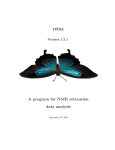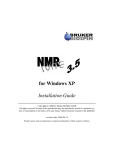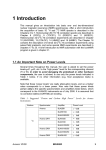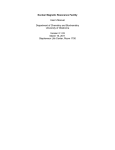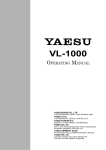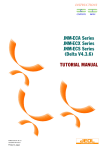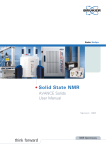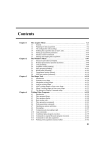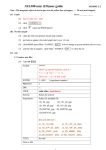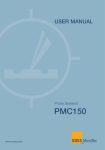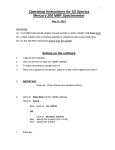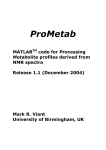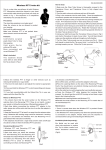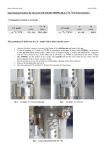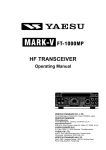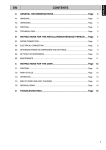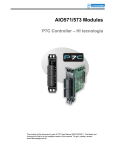Download Tuning and Matching
Transcript
Chapter Preparing for Acquisition 2 Goto Sample Preparation 2.1 The quality of the sample can have a significant impact on the quality of its NMR spectrum. The following is a brief list of suggestions to ensure high sample quality. Always use clean and dry sample tubes to avoid contaminating the sample. Always use good to high quality sample tubes to avoid unnecessary difficulties in shimming. Filter the sample solution. Always use the same sample volume or solution height. This minimizes the shimming that needs to be done between sample changes. Recommended values are for 5 mm tubes: 0.6 ml or 4 cm of solution, and for 10 mm tubes: 4.0 ml or 4 cm of solution. Use the depth gauge to position the sample tube correctly in the spinner. This is discussed further in Chapter 5 ‘Sample Positioning’ of the BSMS User’s Manual. Check that the sample tube is held tightly in the spinner so that it does not slip during an experiment. Wipe the sample tube clean before inserting it into the magnet. For experiments using sample spinning, be sure the spinner, especially the reflectors, is clean. This is important so that the correct spinning rate can be maintained. Tuning and Matching the Probehead 2.2 Once the sample is inserted, the probehead should be tuned and matched. Notice that correct tuning and matching is especially important for higher frequencies. In general, the probehead should be tuned and matched each time a new sample is inserted, each time a new probehead is put in the magnet, and each time the observe or decouple nucleus is changed when using a broadband probe. In a probehead there is a resonant circuit for each observe and decouple nucleus indicated on the probehead label (e.g., one for 1H and one for 13C in a dual 1 H/13 C probehead; one for 1 H and one for a wide range of nuclei in a BBO probehead). There is also a resonant circuit for the lock nucleus, but the standard user will never need to adjust this, so we will ignore it for now. Each of these circuits has a frequency at which it is most sensitive (the resonance frequency). Tuning is the process of adjusting this frequency until it coincides with the frequency of the pulses transmitted to the circuit. For example, the frequency at which the 1 H resonant circuit is most sensitive must be set to the carrier frequency of the 1 H pulses (which is sfo1 if the 1 H circuit is connected to the f1 channel, sfo2 if it is connected to the f2 channel, etc.). A probehead is said to be tuned when all of its resonant circuits are tuned. Once a probehead has been tuned, it is not necessary to retune it after slight adjustments to the carrier frequency, since the probehead is AVANCE User’s Guide Bruker 11 Goto Preparing for Acquisition generally tuned over a range of a couple MHz. On the other hand, large adjustments to the carrier frequency, necessary when changing nuclei, do warrant retuning the probehead, so a broadband probe needs to be retuned each time the heteronucleus is changed. Matching is the process of adjusting the impedance of the resonant circuit until it corresponds with the impedance of the transmission line connected to it. This impedance is 50 Ω . Correct matching minimizes the power that is reflected by the probehead, and so is lost; or equivalently, maximizes the power that is transmitted to the coil, and so is available to do NMR. A probehead is said to be matched when all of its resonant circuits are matched. Again, once a probehead has been matched, it is not necessary to rematch it after slight adjustments to the carrier frequency. On the other hand, large adjustments to the carrier frequency, necessary when changing nuclei, do warrant rematching the probehead. Tuning and matching are carried out simultaneously using the XWIN-NMR command wobb (wobble). During wobbling, a low power signal is transmitted to the probehead. This signal is swept over a frequency range determined by the parameter wbsw (the default value is 4 MHz) centered on the carrier frequency (i.e., sfo1, sfo2, etc., depending on which nucleus is being tuned/matched). Within the preamp (High Performance Preamplifier Assembly or HPPR), the impedance of the probe over this frequency range is compared to the impedance of a 50Ω resistor. The results are shown both on the LED display of the HPPR and in the acquisition submenu in XWIN-NMR. Both displays show the reflected power of the probehead versus the frequency of the signal. The user observes either one or both of these displays while tuning and matching the probehead. Tuning and Matching 1 H 2.2.1 When the NMR experiments to be performed are 1 H homonuclear experiments (e.g., 1 H 1D spectroscopy, COSY, NOESY, or TOCSY), it is only necessary to tune and match the 1H circuit of the probehead. Make sure that the sample is in the magnet, and the probehead is connected for standard 1 H acquisition. Note that there is no special configuration for tuning and matching. Also, it is recommended to tune and match without sample spinning. Set the parameters In XWIN-NMR, enter edsp and set the following spectrometer parameters: NUC1 NUC2 NUC3 1H OFF OFF . This automatically sets sfo1 to a frequency appropriate for 1H tuning and matching. There is no need to adjust sfo1 carefully now. Exit edsp by clicking SAVE. Other wobb parameters are wbsw, which determines the wobble sweep width in MHz (the default value is 4 MHz), and wbst, which determines the number of wobble steps over the sweep width (the default value is 256). Both of these parameters may be found in the eda table. No other parameters are required. Start wobbling 12 Bruker AVANCE User’s Guide Goto Tuning and Matching the Probehead Before starting the wobbling procedure, ensure that no acquisition is in progress, e.g., enter stop. Enter acqu to switch to the acquisition window of XWIN-NMR, if it is desired to use this to monitor the tuning and matching. Notice that being in the acquisition window slows down the wobbling procedure, so if the HPPR LED display will be used to monitor tuning and matching, it is best to remain in the main XWIN-NMR window and not switch to the acquisition window. Start the frequency sweep by typing wobb. The curve that appears in the acquisition window is the reflected power as a function of frequency. Unless the probehead is quite far from the correct tuning and matching, there will be a noticeable dip in the curve. When the 1H circuit is properly tuned, the dip will be in the center of the window, denoted by the vertical marker; and when the circuit is properly matched, the dip will extend all the way down to the x axis. Similar information is conveyed by the LED display on the HPPR. The horizontal row of LED’s indicates tuning and the vertical row matching. When the circuit is properly tuned and matched, the number of LED’s lit is minimized. This usually means that only green LED’s, not red, are lit in both the horizontal and vertical displays. Tune and match Adjust the tuning and matching screws (labeled T and M) at the base of the probehead with the special tool provided. Note that the screws are color coded and those for the 1 H circuit are usually yellow. Also note that the screws have a limited range and attempting to turn them beyond this range will damage the probehead. Since there is interplay between tuning and matching, it is generally useful to adjust the T and M screws in an iterative fashion. Turn the M screw until the dip is well matched at some frequency (the dip extends to the x axis and the number of LED’s lit in the vertical HPPR display is minimized). Most likely this will not be the desired frequency. Adjust the T screw slightly to move the dip toward the center of the window, or equivalently, to reduce the number of LED’s lit in the horizontal HPPR display. Rematch the dip by adjusting the M screw. Again, adjust T to move the dip towards the center of the screen and rematch using M. In this manner, continue walking the dip towards the correct resonance frequency. Note that it is possible to run out of range on the M screw. If this happens, return M to the middle of its range, adjust T to get a well matched dip at some frequency, and walk the dip towards the correct frequency as described above. As mentioned above, ideal tuning and matching is when the dip is centered in the window and extends to y = 0 (the x axis) on the acquisition window, or equivalently, when the number of LED’s lit on the preamp is minimized in both the vertical and horizontal display. When the 1H circuit is tuned and matched, exit the wobble routine by typing stop. Click on return to exit the acquisition window and return to the main window. Tuning and Matching 13 C 2.2.2 Since most 13C experiments make use of 1 H decoupling, when tuning and matching a probehead for 13 C, it is generally a good idea also to tune and match for 1H. When tuning and matching a probehead with multiple resonant circuits, it is best first to tune and match the lowest frequency circuit and then to proceed to higher AVANCE User’s Guide Bruker 13 Goto Preparing for Acquisition frequency circuits. The larger capacitors and inductors found in lower frequency resonant circuits can be expected to have larger stray capacitance and inductance than the smaller elements in higher frequency circuits. Thus, one would expect tuning and matching lower frequency circuits to affect the tuning and matching of higher frequency circuits more so than vice versa. So when tuning and matching a probehead for both 1H and 13 C, it is best to make the 13C adjustments first and the 1 H adjustments last. Make sure that the sample is in the magnet, and the probehead is connected for the appropriate experiment. Also, it is recommended to tune and match without sample spinning. Set the parameters In XWIN-NMR, enter edsp and set the following spectrometer parameters: NUC1 NUC2 NUC3 13C OFF OFF . This automatically sets sfo1 to a frequency appropriate for matching. Exit edsp by clicking SAVE. 13 C tuning and Other wobb parameters are wbsw and wbst, as mentioned above. Both of these parameters may be found in the eda table. No other parameters are required. Start wobbling, tune and match Ensure that no acquisition is in progress, e.g., enter stop. Enter acqu to switch to the acquisition window, if this will be used to monitor the tuning and matching. Start the frequency sweep by typing wobb. The curve that appears in the acquisition window is for 13C. Adjust the tuning and matching following the guidelines given above for 1H. Notice that some probeheads (e.g., broadband probeheads) have sliding bars instead of screws, one set labeled tuning and another matching. These probeheads also have a menu of tuning and matching values for several nuclei. Set the tuning and matching sliding bars to the values indicated for 13 C on the menu. Adjust the tuning bar until the dip is well matched at some frequency, and then walk the dip towards the correct frequency as described above for 1H. Once the 13C circuit is tuned and matched, the 13C wobbling must be stopped and 1 H wobbling begun. One straightforward way to do this is as follows: Exit the wobble routine by typing stop. Enter edsp, change to NUC1 to 1H, and exit by clicking SAVE. Then start the 1 H frequency sweep by typing wobb. After a few seconds the 1H curve appears in the acquisition window and the 1 H circuit can be tuned and matched as described above. Alternatively, if the user already has a data set in which NUC1 = 1H and NUC2 = OFF, there is no need to redo edsp for the current data set. The user may simply read in the 1 H data set and then type wobb. Once the probehead is tuned and matched for 13 C and 1H, exit the wobble routine by typing stop. Click on return to exit the acquisition window and return to the main window. 14 Bruker AVANCE User’s Guide Goto Locking and Shimming Locking and Shimming 2.3 Before running an NMR experiment, it is also necessary to lock and shim the magnetic field. Locking To display the lock signal enter lockdisp . This opens a new window in which the lock trace now appears. The most convenient way for the standard user to lock is semi-automatically using the XWIN-NMR command lock. To start the lock-in procedure, enter lock and select the appropriate solvent from the menu that appears. Alternatively, enter the solvent name with the lock command, e.g., lock cdcl3. During lock-in, the lock power, field value, and frequency shift for the solvent are set according to the values in the 2H-Lock table (also known as the edlock table). These values can be edited with the command edlock. Note that the lock power listed in this table is the level used once lock-in has been achieved. The field-shift mode is then selected and autolock is activated. Once lock-in is achieved, the lock gain is set so that the lock signal is visible in the lock window. At this point the message “lock: finished” appears in the status line at the bottom of the window. The lock-in procedure outlined above sets the frequency shift to the exact frequency shift value for the given solvent as listed in the edlock table. It also sets the field value to the value (which is the same for all solvents) listed in the edlock table and then adjusts this slightly to achieve lock-in. As a result, the absolute magnetic field is now nearly the same no matter what lock solvent is used. This has the advantage that offsets can now be defined in ppm, since the absolute frequency corresponding to a given ppm value no longer depends on the lock solvent. Another advantage of following this lock-in procedure is that it automatically sets the parameter solvent correctly in the eda table. This is especially important if you wish to use the automatic calibration command sref, as described later (see “Spectrum Calibration and Optimization” on page 25). It is recommended that each time the probehead is changed, the user adjust the phase of the lock signal while monitoring the sweep wiggles (i.e., while the field is not locked but is being swept). This is necessary if the original lock phase is very far wrong, in which case autolock may fail to achieve lock-in. If the original phase is reasonably close to correct, then lock-in can be achieved and the phase can be adjusted afterwards using autophase. Please note that the lock phase for each probehead is stored in the edlock table. To make shure that XWIN-NMR selects the edlock table assigned to the current probe, enter edhead,then click on Define Current and select your current probe. The other lock parameter that may possibly be problematic when using the XWINNMR lock command is the lock power. In some instances, the power level listed in the edlock table is too high, meaning that the lock signal is always saturated. Usually, in this situation lock-in can be achieved, but since the signal is saturated, it oscillates. A quick fix is simply to reduce the lock power by hand once lock-in has been achieved. A better fix is to change the power level in the edlock table. Note that the appropriate lock power level depends on the lock solvent, the field value, and the probehead. Shimming AVANCE User’s Guide Bruker 15 Goto Preparing for Acquisition If the probehead has just been changed, the first step in shimming the magnetic field is to read in the shim file corresponding to the new probehead. Enter rsh and then select the appropriate file from the menu that appears. Assuming that the shim file is a good one, or that a prior user has shimmed the field for the current probehead, the user need only adjust the Z and Z 2 shims (and possibly the X and Y). Generally, the shims are adjusted while viewing the lock signal and the best shim values correspond to the highest lock level (height of the lock signal in the window). For further discussion of shimming see Chapter 6 ‘Shim Operation’ of the BSMS User’s Manual. Optimize lock settings (optional) Once the magnetic field has been locked and shimmed, the user may wish to optimize the lock settings as described below. It is strongly recommended to follow this procedure before running any experiment requiring optimal stability (e.g., NOE difference experiments). After the field is locked and shimmed, start the auto-power routine from the BSMS keyboard (see Chapter 2 ‘Key Description’ of the BSMS User’s Manual). For lock solvents with long T 1 relaxation times (e.g., CDCl3), however, auto power may take an unacceptably long time and the lock power should be optimized manually. Simply increase the lock power level until the signal begins to oscillate (i.e., until saturation), and then reduce the power level slightly (approximately 3 dB). For example, if the lock signal begins to oscillate at a power of –15 dB, the optimal magnetic field stability can be expected when a level of approximately –18 dB (or even –20 dB) is used. The field stability will be significantly worse if a power level of, say, –35dB is used instead. When the lock power is optimized, start the auto-phase routine, and finally the autogain routine. Take note of the gain value determined by auto gain. Using this value, select the appropriate values for the loop filter, loop gain, and loop time as shown below in Table 2. 16 Bruker AVANCE User’s Guide Goto Locking and Shimming Table 2. Lock Parameters (BSMS Firmware Version 940614) Lock RX Gain (after auto gain) [dB] Loop Filter [Hz] Loop Gain [dB] Loop Time [sec] 120 20 –17.9 0.681 30 –14.3 0.589 50 –9.4 0.464 70 –6.6 0.384 100 –3.7 0.306 160 0.3 0.220 250 3.9 0.158 400 7.1 0.111 600 9.9 0.083 1000 13.2 0.059 1500 15.2 0.047 2000 16.8 0.041 110 90 So, for example if auto gain determines a lock gain of 100dB, the user should set the loop filter to 160 Hz, the loop gain to 0.3 dB, and the loop time to 0.220 sec (see Chapter 4 ‘Menu Description’ of the BSMS User’s Manual for how to set these parameters from the BSMS keyboard). AVANCE User’s Guide Bruker 17 Goto Preparing for Acquisition 18 Bruker AVANCE User’s Guide









